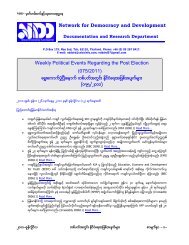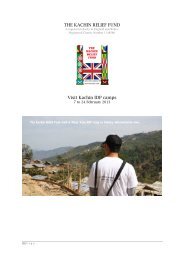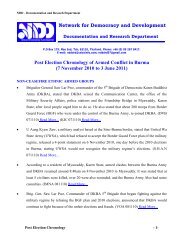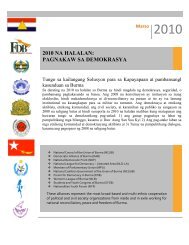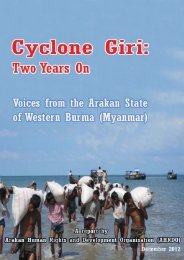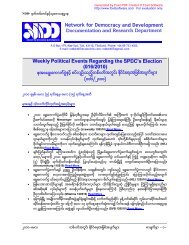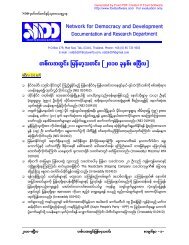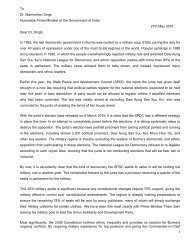The case for revenue transparency in the oil and gas ... - La'o Hamutuk
The case for revenue transparency in the oil and gas ... - La'o Hamutuk
The case for revenue transparency in the oil and gas ... - La'o Hamutuk
Create successful ePaper yourself
Turn your PDF publications into a flip-book with our unique Google optimized e-Paper software.
Appendix: Sources of government <strong>revenue</strong>s<br />
<strong>The</strong> follow<strong>in</strong>g is a breakdown of general sources of government<br />
<strong>revenue</strong>s from <strong>the</strong> sale of <strong>oil</strong> <strong>and</strong> natural <strong>gas</strong>. Us<strong>in</strong>g available<br />
production shar<strong>in</strong>g contracts (PSCs) <strong>and</strong> secondary sources, estimated<br />
calculations are provided <strong>for</strong> 1) royalties; 2) government share of profit<br />
<strong>gas</strong>/petroleum; 3) government participation; 4) signature bonus; 5)<br />
production bonuses; 6) taxes; <strong>and</strong> 7) fees.<br />
Two caveats should be kept <strong>in</strong> m<strong>in</strong>d when read<strong>in</strong>g estimated amounts:<br />
1) PSC provisions are negotiable, <strong>and</strong> are not exactly <strong>the</strong> same <strong>for</strong><br />
each project or contract; <strong>and</strong> 2) due to restrictions on <strong>in</strong><strong>for</strong>mation<br />
<strong>in</strong>side Burma, only a limited amount of <strong>in</strong><strong>for</strong>mation regard<strong>in</strong>g PSCs is<br />
currently available. This section uses three PSCs plus secondary sources<br />
to estimate general <strong>revenue</strong> sources from natural <strong>gas</strong> <strong>and</strong> petroleum<br />
operations. It is meant to provide general examples <strong>and</strong> highlight <strong>the</strong><br />
types of <strong>revenue</strong>s that activists should be aware of when research<strong>in</strong>g<br />
an <strong>oil</strong> or <strong>gas</strong> project. It is by no means representative of every PSC <strong>in</strong><br />
Burma, as each contract will be somewhat different.<br />
Royalties<br />
<strong>The</strong> government takes royalties of 10% of Available Gas/Petroleum.<br />
Royalties can be taken <strong>in</strong> cash or <strong>in</strong> k<strong>in</strong>d, <strong>and</strong> are to be paid at <strong>the</strong> end<br />
of each quarter. <strong>The</strong>y are not cost recoverable. 124<br />
Government Share of Profit Gas/Petroleum<br />
After <strong>gas</strong>/petroleum is taken <strong>for</strong> royalties <strong>and</strong> cost recovery, <strong>the</strong><br />
government takes a share of what is left, or <strong>the</strong> Profit Gas/Petroleum.<br />
<strong>The</strong> amount of <strong>gas</strong>/petroleum taken by <strong>the</strong> government depends on<br />
several factors, <strong>in</strong>clud<strong>in</strong>g daily rate of production, depth of offshore<br />
discovery, <strong>and</strong> price calculations.<br />
In <strong>the</strong> older Yadana PSC (1992), <strong>the</strong> government share of Profit Gas/<br />
Petroleum is calculated accord<strong>in</strong>g to a complex <strong>for</strong>mula based on <strong>the</strong><br />
average quarterly export market <strong>gas</strong> price <strong>and</strong> daily rate of production.<br />
Depend<strong>in</strong>g on <strong>the</strong> results, <strong>the</strong> government share of <strong>gas</strong>/petroleum is<br />
between 40% <strong>and</strong> 90%. 135 In <strong>the</strong> more recent Block AD-1 <strong>and</strong> AD-8 PSCs<br />
(2007), <strong>the</strong> government share of Profit Gas/Petroleum is calculated<br />
accord<strong>in</strong>g to depth of offshore discovery <strong>and</strong> daily rate of production. 136<br />
<strong>The</strong> government is also entitled to a domestic <strong>gas</strong>/petroleum supply<br />
requirement of up to 20% of <strong>the</strong> Consortium’s Profit Gas/Petroleum.<br />
<strong>The</strong> <strong>gas</strong>/petroleum must be provided to <strong>the</strong> government at a 10%<br />
discount. 137<br />
Government Participation<br />
<strong>The</strong> 100% government-owned Myanma Oil <strong>and</strong> Gas Enterprise (MOGE)<br />
has <strong>the</strong> right to dem<strong>and</strong> a 15% stake <strong>in</strong> <strong>the</strong> project Consortium. 125 If<br />
so, MOGE will reimburse <strong>the</strong> Consortium 15% of <strong>the</strong> signature <strong>and</strong><br />
production bonuses <strong>and</strong> provide a share of <strong>the</strong> costs. 126 In <strong>the</strong> more<br />
recent Block AD-1 <strong>and</strong> AD-8 PSCs, MOGE has <strong>the</strong> right to dem<strong>and</strong> a<br />
40





